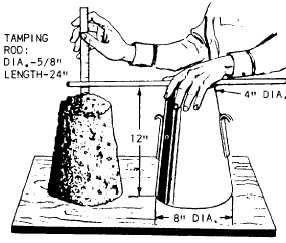wet by a rainstorm, the proportion of water in the mix may have to be changed.
Measuring Aggregate
The accuracy of aggregate measurement by volume depends upon the accuracy with which the amount of "bulking," caused by moisture in the aggregate, can be determined. The amount of bulking varies not only with different moisture contents but also with different gradations. Fine sand, for example, is bulked more than coarse sand by the same moisture content. Furthermore, moisture content itself varies from time to time, and a small variation causes a large change in the amount of bulking. For these and other reasons, aggregate should be measured by weight rather than by volume whenever possible.
To make grading easier, to keep segregation low, and to ensure that each batch is uniform, you should store and measure coarse aggregate from separate piles or hoppers. The ratio of maximum to minimum particle size should not exceed 2:1 for a maximum nominal size larger than 1 inch. The ratio should not exceed 3:1 for a maximum nominal size smaller than 1 inch. A mass of aggregate with a nominal size of 1 1/2 inches to 1/4 inch, for example, should be separated into one pile or hopper containing 1 1/2-inch to 3/4-inch aggregate, and another pile or hopper containing 3/4-inch to 1/4-inch aggregate. A mass with a nominal size of 3 inches to 1/4 inch should be separated into one pile or hopper containing 3-inch to 1 1/2-inch aggregate, another containing 1 1/2-inch to 3/4-inch aggregate, and a third containing 3/4-inch to 1/4-inch aggregate.
Water-Cement Ratio
The major factor controlling strength, everything else being equal, is the amount of water used per bag of cement. Maximum strength is obtained by using just the amount of water, and no more, required for the complete hydration of the cement. As previously mentioned, however, a mix of this type maybe too dry to be workable. Concrete mix always contains more water than the amount required to attain maximum strength. The point for you to remember is that the strength of concrete decreases as the amount of extra water increases.
The specified water-cement ratio is the happy medium between the maximum possible strength of the concrete and the necessary minimum workability requirements. The strength of building concrete is expressed in terms of the compressive strength in pounds per square inch (psi) reached after a 7- or 28-day set. This is usually referred to as "probable average 7-day strength" and "probable average 28-day strength."
SLUMP TESTING
Slump testing is a means of measuring the consistency of concrete using a "slump cone." The cone is made of galvanized metal with an 8-inch-diameter base, a 4-inch-diameter top, and a 12-inch height. The base and the top are open and parallel to each other and at right angles to the axis of the cone (figure 6-4). A tamping rod 5/8 inch in diameter and 24 inches long is also needed. The tamping rod should be smooth and bullet-pointed. Do not use a piece of reinforcing bar (rebar).
Samples of concrete for test specimens are taken at the mixer or, in the case of ready-mixed concrete, from the transportation vehicle during discharge. The sample of concrete from which test specimens are made should be representative of the entire batch. Such samples are obtained by repeatedly passing a scoop or pail through the discharging stream of concrete, starting the sampling operation at the beginning of discharge, and repeating the operation until the entire batch is discharged. To counteract segregation when a sample must be transported to a test site, the concrete should be remixed with a shovel until it is uniform in appearance. The job location from which the sample was taken should be noted for future reference. In the case of paving concrete,

Figure 6-4.-Measurement of slump.
Continue Reading